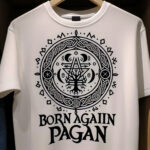Norway is a country with a rich cultural and spiritual history, dating back to the Viking Age when the Norse worshipped the gods of Asgard. While Christianity has been the predominant religion in Norway since the Middle Ages, there are still many pagan sites scattered throughout the country that give one a glimpse into the past. In this article, we will explore some of Norway’s most interesting pagan sites and the stories behind them.

Norway is home to a rich history of pagan sites, many of which are still standing today as a testament to the Viking era. From ancient burial grounds to stone circles, these sites are evidence of the spiritual beliefs of the Norse people. In this article, we will explore some of Norway’s most significant pagan sites and discover what makes them so special.
Ullandhaug Stone Circle
The Ullandhaug Stone Circle is located near Stavanger in southwestern Norway. The circle is made up of nearly 40 stones, most of them standing upright, with a few fallen stones still visible. The stones range in size from one to three metres tall. While the exact purpose of the circle is not known, it is believed to have been used for religious ceremonies, possibly to honour the Norse gods. The Ullandhaug Stone Circle is one of the oldest and best-preserved pagan sites in Norway and is an important part of the country’s history.
Oseberg Ship Burial
The Oseberg Ship Burial is a well-preserved Viking ship burial site located near Tønsberg in southern Norway. The burial site dates back to the 9th century and contains the remains of an ancient Norse ship and the remains of two women. The ship is thought to have been used to transport the women to their final resting place, and the burial site is a testament to the importance of the afterlife in Norse culture. The Oseberg Ship Burial is an important part of Norway’s history and is a popular tourist attraction.
Borg in Lofoten
Borg in Lofoten is an ancient Viking fortress located in the Lofoten Islands in northern Norway. The fortress is believed to have been built in the 10th century and is one of the best-preserved Viking sites in Norway. The site is made up of a large, circular stone wall, which was used to protect the inhabitants from invaders. Inside the fortress are the remains of several longhouses, as well as a pagan altar. Borg in Lofoten is an important part of Norway’s history and is a popular tourist destination.
Gol Stave Church
The Gol Stave Church is a well-preserved wooden church located in Gol, Norway. The church dates back to the 12th century and is one of the oldest surviving stave churches in Norway. The church is made up of four large wooden poles, which were used to support the roof. Inside the church is an altar and several other artifacts, including a pagan symbol called a valknut. The Gol Stave Church is an important part of Norway’s history and is a popular tourist attraction.
Jelling Stones
The Jelling Stones are two rune stones located in Jelling, Denmark. The stones date back to the 10th century and are believed to have been erected by King Harald Bluetooth in honor of his parents. The stones are inscribed with runes and depict a Christian cross and a pagan symbol. The Jelling Stones are an important part of Norway’s history and are a popular tourist attraction.
Vikingskipet
Vikingskipet is an open-air museum located in Oslo, Norway. The museum is made up of a replica Viking longship, as well as several other artifacts from the Viking era. The ship is believed to have been used by the Vikings for trade and exploration, and the museum is a great way to learn more about the Vikings and their culture. Vikingskipet is an important part of Norway’s history and is a popular tourist destination.
Conclusion
Norway is home to a rich history of pagan sites, many of which are still standing today as a testament to the Viking era. From ancient burial grounds to stone circles, these sites are evidence of the spiritual beliefs of the Norse people. While the exact purpose of some of these sites is still unknown, they are all important parts of Norway’s history and are popular tourist destinations.
Norway’s pagan sites are an important part of the country’s cultural heritage, and provide a fascinating insight into the past. They are a reminder of the importance of preserving our cultural heritage and of the need to continue to study and understand the beliefs and practices of our ancestors. The sites are a testament to the resilience and creativity of the people who have lived in Norway for centuries, and the importance of the natural environment to their lives. With the increasing popularity of these sites, it is important to ensure that they are maintained and respected, so that future generations can continue to appreciate and learn from them.





